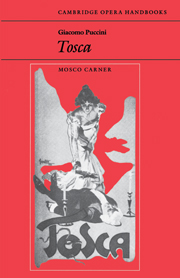Book contents
- Frontmatter
- General preface
- Contents
- List of illustrations
- 1 Sardou and his La Tosca
- 2 Naturalism in opera: verismo
- 3 Genesis of Tosca
- 4 Synopsis
- 5 Play and opera: a comparison
- 6 First production and critical history
- 7 Interpretation: some reflections
- 8 Style and technique
- 9 Musical and dramatic structure
- 10 Analysis: Act I in perspective
- 11 Tosca in the United States
- Notes
- Select bibliography
- Discography by Malcolm Walker
- Index
6 - First production and critical history
Published online by Cambridge University Press: 04 August 2010
- Frontmatter
- General preface
- Contents
- List of illustrations
- 1 Sardou and his La Tosca
- 2 Naturalism in opera: verismo
- 3 Genesis of Tosca
- 4 Synopsis
- 5 Play and opera: a comparison
- 6 First production and critical history
- 7 Interpretation: some reflections
- 8 Style and technique
- 9 Musical and dramatic structure
- 10 Analysis: Act I in perspective
- 11 Tosca in the United States
- Notes
- Select bibliography
- Discography by Malcolm Walker
- Index
Summary
With the action of the opera set in Rome, Ricordi's choice (first suggested by Illica) of the Italian capital for the first production was as appropriate as it was diplomatic, since it was calculated to flatter the Roman public's amour propre as well as its local patriotism. But evidently the publisher had not reckoned with two things. The first was the implied anti-clericalism of the opera manifest not only in Cavaradossi but also in the fact that its villain was himself portrayed as a devout believer; this threw an odd light on the Catholic Church and would probably go against the grain of many spectators, to say nothing of the Vatican. The second thing likely to have an adverse influence on the opera's reception was the traditional antagonism that existed (and seems still to exist) between Rome and the cities of northern Italy. But what Ricordi could not foresee was that the disturbed political atmosphere of the time would greatly contribute to the nervous tension that reigned at the Teatro Costanzi on the evening of the first night – 14 January 1900. There was, incidentally, a notable coincidence: ten years earlier Mascagni had launched at the same theatre his Cavalleria rusticana, which marked the birth of verismo.
The three principal roles were taken by Haricleé Darclée (Tosca), Emilio De Marchi (Cavaradossi) and Eugenio Giraldoni (Scarpia). Darclée seems to have been chosen for the part less for her vocal accomplishments than for her striking beauty and her talent as an actress.
- Type
- Chapter
- Information
- Giacomo Puccini: Tosca , pp. 64 - 76Publisher: Cambridge University PressPrint publication year: 1985



